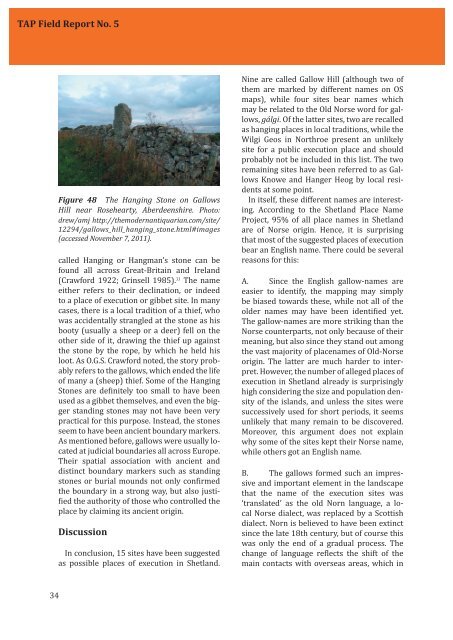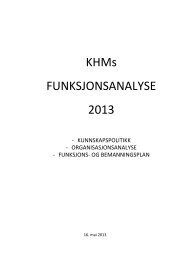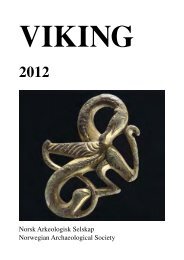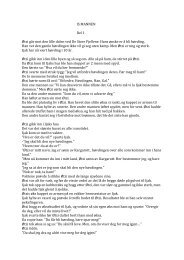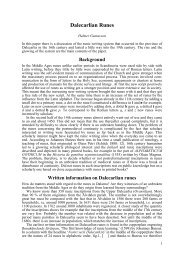TAP Field Report No. 5 A survey of Shetland's gallow hills Joris ...
TAP Field Report No. 5 A survey of Shetland's gallow hills Joris ...
TAP Field Report No. 5 A survey of Shetland's gallow hills Joris ...
- No tags were found...
You also want an ePaper? Increase the reach of your titles
YUMPU automatically turns print PDFs into web optimized ePapers that Google loves.
<strong>TAP</strong> <strong>Field</strong> <strong>Report</strong> <strong>No</strong>. 5Figure 48 The Hanging Stone on GallowsHill near Rosehearty, Aberdeenshire. Photo:drew/amj http://themodernantiquarian.com/site/12294/<strong>gallow</strong>s_hill_hanging_stone.html#images(accessed <strong>No</strong>vember 7, 2011).called Hanging or Hangman’s stone can befound all across Great-Britain and Ireland(Crawford 1922; Grinsell 1985). 33 The nameeither refers to their declination, or indeedto a place <strong>of</strong> execution or gibbet site. In manycases, there is a local tradition <strong>of</strong> a thief, whowas accidentally strangled at the stone as hisbooty (usually a sheep or a deer) fell on theother side <strong>of</strong> it, drawing the thief up againstthe stone by the rope, by which he held hisloot. As O.G.S. Crawford noted, the story probablyrefers to the <strong>gallow</strong>s, which ended the life<strong>of</strong> many a (sheep) thief. Some <strong>of</strong> the HangingStones are deinitely too small to have beenused as a gibbet themselves, and even the biggerstanding stones may not have been verypractical for this purpose. Instead, the stonesseem to have been ancient boundary markers.As mentioned before, <strong>gallow</strong>s were usually locatedat judicial boundaries all across Europe.Their spatial association with ancient anddistinct boundary markers such as standingstones or burial mounds not only conirmedthe boundary in a strong way, but also justi-ied the authority <strong>of</strong> those who controlled theplace by claiming its ancient origin.DiscussionIn conclusion, 15 sites have been suggestedas possible places <strong>of</strong> execution in Shetland.Nine are called Gallow Hill (although two <strong>of</strong>them are marked by different names on OSmaps), while four sites bear names whichmay be related to the Old <strong>No</strong>rse word for <strong>gallow</strong>s,gálgi. Of the latter sites, two are recalledas hanging places in local traditions, while theWilgi Geos in <strong>No</strong>rthroe present an unlikelysite for a public execution place and shouldprobably not be included in this list. The tworemaining sites have been referred to as GallowsKnowe and Hanger Heog by local residentsat some point.In itself, these different names are interesting.According to the Shetland Place NameProject, 95% <strong>of</strong> all place names in Shetlandare <strong>of</strong> <strong>No</strong>rse origin. Hence, it is surprisingthat most <strong>of</strong> the suggested places <strong>of</strong> executionbear an English name. There could be severalreasons for this:A. Since the English <strong>gallow</strong>-names areeasier to identify, the mapping may simplybe biased towards these, while not all <strong>of</strong> theolder names may have been identiied yet.The <strong>gallow</strong>-names are more striking than the<strong>No</strong>rse counterparts, not only because <strong>of</strong> theirmeaning, but also since they stand out amongthe vast majority <strong>of</strong> placenames <strong>of</strong> Old-<strong>No</strong>rseorigin. The latter are much harder to interpret.However, the number <strong>of</strong> alleged places <strong>of</strong>execution in Shetland already is surprisinglyhigh considering the size and population density<strong>of</strong> the islands, and unless the sites weresuccessively used for short periods, it seemsunlikely that many remain to be discovered.Moreover, this argument does not explainwhy some <strong>of</strong> the sites kept their <strong>No</strong>rse name,while others got an English name.B. The <strong>gallow</strong>s formed such an impressiveand important element in the landscapethat the name <strong>of</strong> the execution sites was‘translated’ as the old <strong>No</strong>rn language, a local<strong>No</strong>rse dialect, was replaced by a Scottishdialect. <strong>No</strong>rn is believed to have been extinctsince the late 18th century, but <strong>of</strong> course thiswas only the end <strong>of</strong> a gradual process. Thechange <strong>of</strong> language relects the shift <strong>of</strong> themain contacts with overseas areas, which in34


